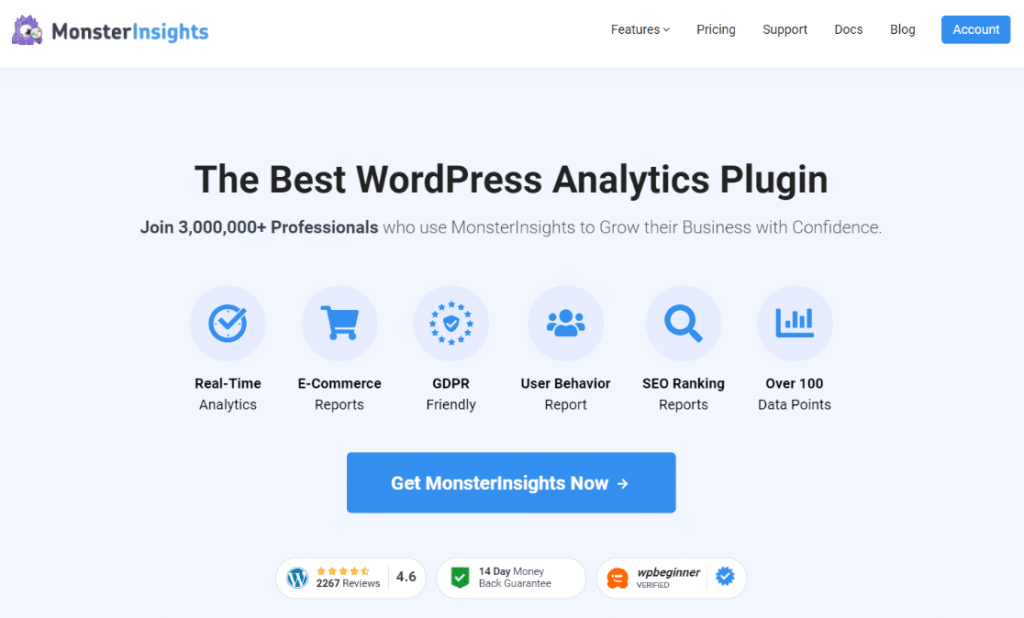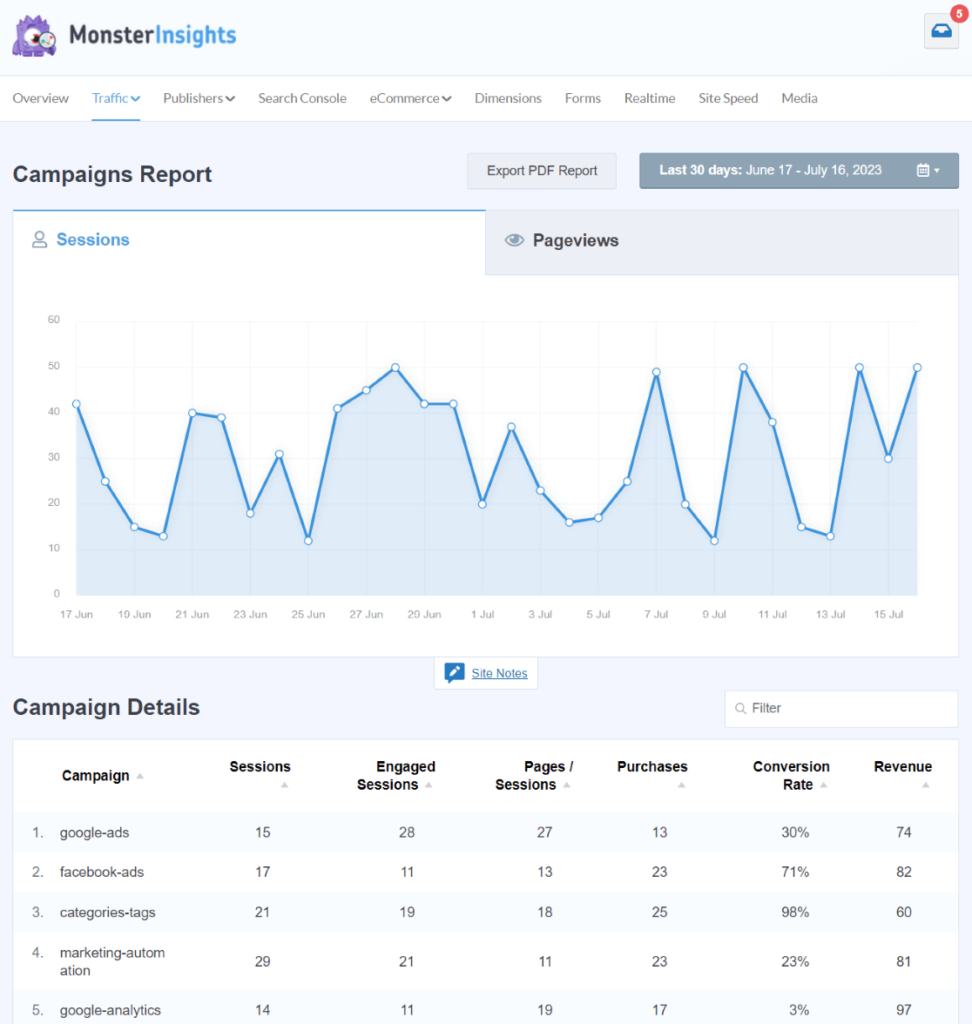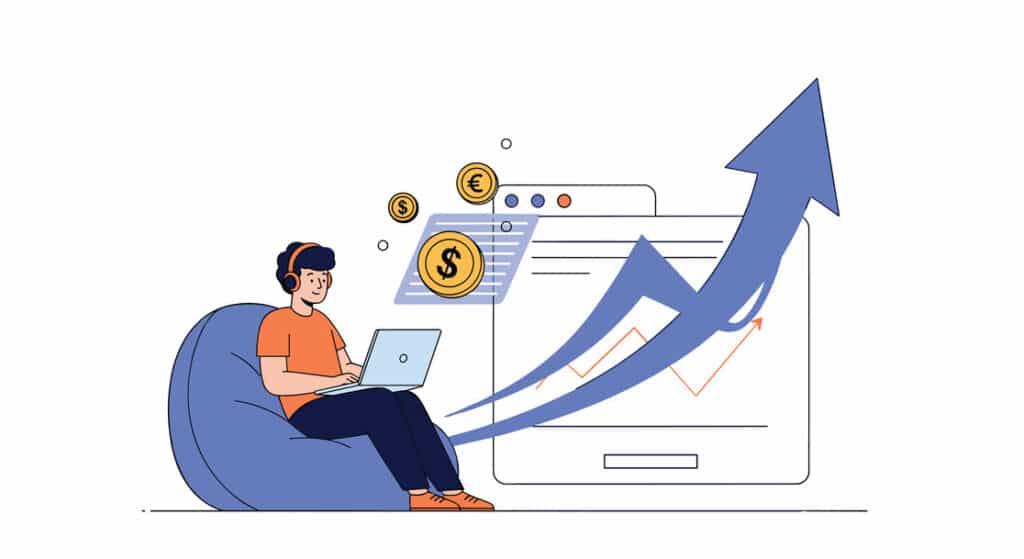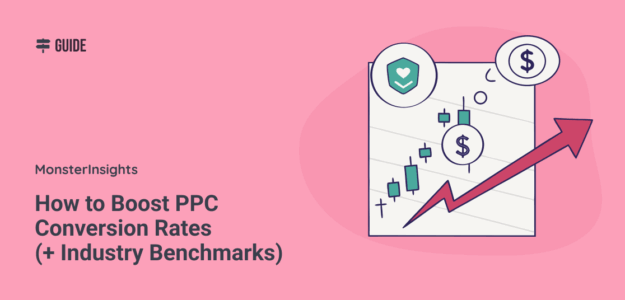You’re spending hundreds or thousands of dollars on PPC ads every month, but your PPC conversion rates are disappointing. Every click costs money, yet most visitors leave without taking action. This frustrating reality affects countless businesses running pay-per-click campaigns.
The difference between a mediocre 2% conversion rate and an excellent 8% rate can mean the difference between losing money and generating serious profit from your ads.
PPC conversion rate optimization isn’t just about tweaking a few settings. It requires understanding benchmarks, analyzing your industry’s performance, and implementing proven strategies that turn more clicks into customers.
And that’s exactly what I’ll cover in this guide!
Table of Contents:
What Is PPC Conversion Rate?
PPC conversion rate measures the percentage of people who complete a desired action after clicking your paid ads. This action could be making a purchase, filling out a contact form, downloading a resource, or signing up for a trial.
The conversion rate directly impacts your return on investment. According to Google, businesses make an average of $2 for every $1 spent on Google Ads, but this varies dramatically based on your conversion rate.
Your PPC conversion rate serves as a key performance indicator for several reasons:
- Budget efficiency: Higher rates mean more value from each advertising dollar
- Campaign effectiveness: Shows how well your ads align with audience needs
- Competitive advantage: Better rates help you outbid competitors profitably
- Business growth: More conversions directly translate to increased revenue
How to Calculate PPC Conversion Rate
Calculating your PPC conversion rate uses a straightforward formula:
(Number of Conversions ÷ Number of Clicks) × 100 = Conversion Rate %
Here’s a practical example: Your ad receives 1,000 clicks and generates 50 conversions. Your calculation would be:
(50 ÷ 1,000) × 100 = 5%
This means 5% of people who clicked your ad completed the desired action.
I recommend tracking conversions at different levels:
- Individual ad performance: Identifies your best-performing ads
- Campaign-level rates: Shows overall strategy effectiveness
- Keyword conversion rates: Reveals which search terms drive results
- Landing page performance: Measures post-click conversion success
Most advertising platforms provide conversion tracking tools. Google Ads, Facebook Ads Manager, and Microsoft Advertising all offer built-in conversion measurement.
Check out Master PPC ROI: How to Calculate and Improve Your Return to learn more.
What Is a Good PPC Conversion Rate?

The average PPC conversion rate across all industries is approximately 2.35%. However, “good” varies significantly by industry and campaign type.
Based on my experience managing PPC campaigns, here’s how I categorize conversion rates:
- Poor Performance: Below 1%
- Average Performance: 1-3%
- Good Performance: 3-7%
- Excellent Performance: 7%+
The top 25% of advertisers achieve conversion rates of 11.45% or higher, proving that exceptional performance is possible with proper conversion rate optimization.
Several factors influence a good rate for your business:
- Industry competition: Highly competitive sectors often see lower rates
- Product price point: Higher-priced items typically convert at lower rates
- Sales cycle length: B2B services with long cycles may have different benchmarks
- Traffic quality: Highly targeted campaigns generally convert better
- Conversion definition: Easy actions (email signup) convert higher than purchases
I always tell clients to focus on improvement rather than absolute benchmarks. Doubling a 2% rate to 4% can transform campaign profitability, regardless of industry standards.
If you’re new to this space, read PPC Campaign Optimization: Complete Guide to Boost Your ROI.
PPC Conversion Rates by Industry
Industry benchmarks provide context for evaluating your performance. Based on analysis of conversion data across 20+ industry studies, here are average PPC conversion rates by industry:
High-Converting Industries (8%+)
- Animals & Pets: 16.3%
- Media & Entertainment: 18.1%
- Physicians & Surgeons: 16.1%
- Automotive Repair & Service: 12.6%
- Events & Leisure: 12.9%
- Dentists & Dental Services: 10.4%
- Health & Fitness: 11.0%
- Home & Home Improvement: 10.2%
- Restaurants & Food: 10.1%
- Software as a Service: 9.5%
Medium-Converting Industries (3-8%)
- Beauty & Personal Care: 7.9%
- Travel: 7.5%
- Business Services: 6.8%
- Finance & Insurance: 6.5%
- Healthcare: 6.5%
- Agency Services: 6.1%
- Sports & Recreation: 5.9%
- Automotive Sales: 5.7%
- Real Estate: 4.4%
- Arts & Entertainment: 4.5%
Lower-Converting Industries (Below 3%)
These variations exist because of different factors like purchase consideration time, product complexity, and competition levels.
A software company selling enterprise solutions naturally has a longer sales cycle than a restaurant promoting lunch specials.
Meanwhile, fashion and furniture purchases involve more consideration time, resulting in lower immediate conversion rates.
I’ve noticed that service-based industries consistently outperform product-based sectors. The immediacy of service needs (dental emergency, legal consultation) drives faster decision-making than product purchases.
Platform-Specific Conversion Rates
Different advertising platforms produce varying conversion rates due to user intent and behavior patterns:
Google Ads:
Facebook/Instagram Ads: 9.21% average across all industries
Microsoft Ads (Bing): 2.94% average
Other Social Platforms:
Amazon Ads: 9.89% average (eCommerce focused)
Google Search ads typically perform best because users are actively searching for solutions. Social media platforms like Facebook work better for discovery and brand awareness, which can lead to higher conversion rates when properly targeted.
Additional Industry Benchmarks:
According to Unbounce’s conversion rate benchmark report, a conversion rate between 2% to 5% is typical across industries, with exceptional campaigns achieving rates above 10%.
Track Your PPC Conversions Accurately with MonsterInsights
Understanding industry benchmarks is valuable, but you can’t improve what you don’t measure properly. Many businesses struggle with PPC conversion tracking because setting up comprehensive measurement across multiple platforms requires technical expertise that most marketing teams don’t have.
Most businesses face these common tracking problems:
- Complex Google Tag Manager setups that require developer knowledge
- Disconnected data across Google Ads, Facebook, and Microsoft Advertising platforms
- Inability to connect PPC performance with actual revenue and business outcomes
- Time-consuming manual reporting that delays optimization decisions
This is where MonsterInsights transforms PPC management for WordPress users.
Why MonsterInsights is Perfect for PPC Conversion Tracking
MonsterInsights is the leading Google Analytics plugin for WordPress, designed specifically to eliminate technical barriers while providing enterprise-level tracking capabilities.

Key Benefits for PPC Optimization:
- Universal PPC Integration: Connect Google Ads, Microsoft Advertising, and Meta Ads from one dashboard without touching any code. No Google Tag Manager complexity required.
- No-Code Conversion Tracking: Set up advanced eCommerce tracking, form conversions, and button click tracking with simple toggles. Perfect for non-technical users who need professional-grade measurement.
- Unified Reporting: View PPC performance alongside organic traffic, social media, and direct traffic in your WordPress dashboard. This complete picture helps you understand how PPC fits into your overall marketing strategy.
- Revenue Attribution: Track which specific campaigns, ad groups, and keywords generate actual revenue. Essential for eCommerce businesses that need to optimize for profit, not just conversions.
- Real-Time Performance Monitoring: Check campaign performance without switching between multiple platforms or waiting for data delays.
Quick Setup Process
Setting up comprehensive PPC tracking with MonsterInsights takes just minutes:
- Install MonsterInsights Pro: Choose the Plus plan or higher to access PPC tracking features
- Complete the Setup Wizard: Connect your Google Analytics account through the guided setup process
- Enable PPC Tracking: Navigate to Insights » Settings » Conversions and activate the PPC addon
- Connect Your Ad Accounts: Enter your Google Ads conversion ID, Meta Pixel ID, and Microsoft UET tag
- Configure Goals: Set up the specific actions you want to track as conversions
And that’s it. You’ll now see your campaigns performance right inside WordPress:

This streamlined approach means you spend time optimizing campaigns instead of wrestling with the technical setup.
The Result: More accurate data, better optimization decisions, and improved ROI from your PPC investments. You’ll finally see which campaigns drive real business results instead of guessing based on incomplete information.
How to Improve Your PPC Conversion Rate

I’ve identified eight proven strategies that consistently improve PPC conversion rates across industries:
1. Optimize Landing Page Experience
Your landing page determines whether clicks become conversions. So you want to make sure you have excellent landing pages, setting you up for success.
Essential landing page elements:
- Message match: Landing page headline should mirror ad copy
- Single clear objective: Focus on one primary conversion goal
- Fast loading speed: Pages should load under 2 seconds
- Mobile optimization: Most PPC traffic comes from mobile devices
- Trust signals: Include testimonials, security badges, and contact information
- Compelling call-to-action: Use action-oriented language like “Get Started for Free”
Pro Tip: I use MonsterInsights to track landing page performance directly in WordPress. This makes it easy to see which pages convert best and identify improvement opportunities.
2. Align Ad Copy with Landing Pages
Mismatched messaging between ads and landing pages kills conversions. When someone clicks an ad promising “20% off running shoes,” they expect to land on a page featuring that exact offer. If this is not what the user sees, they’re likely to bounce off your pages without buying.
I always ensure:
- Headlines match between ad and landing page
- Offers remain consistent throughout the experience
- Visual elements support the same message
- Keywords from ads appear on landing pages
This alignment also improves Google Ads Quality Score, reducing your cost-per-click while improving ad positions.
Check out How to Master PPC Analysis: Best Tools, Metrics & Strategies.
3. Refine Audience Targeting
Broad targeting wastes budget on unqualified clicks. I achieve better conversion rates by creating specific audience segments based on:
- Demographics: Age, income, location, interests
- Behavioral data: Previous website visitors, purchase history
- Custom audiences: Lookalike audiences based on existing customers
- Intent signals: Specific keywords indicating purchase readiness
Example: Instead of targeting “sports fans,” target “women aged 25-45 interested in yoga and living within 10 miles of your studio.”
4. Implement Smart Bidding Strategies
Conversion-focused bidding strategies optimize for actions rather than just clicks. I recommend:
- Target CPA: Set your desired cost per conversion
- Target ROAS: Optimize for return on ad spend
- Maximize Conversions: Get the most conversions within your budget
These automated strategies use machine learning to identify users most likely to convert, improving your rates over time.
I’ve written a complete guide on this topic, and you can check it out here: Your Complete Guide to AI-Optimized PPC Campaigns.
5. Use Remarketing Campaigns
Studies show that remarketing can improve ad campaign effectiveness by 400%. People rarely convert on first exposure, but remarketing keeps your brand visible during their decision process.
Effective remarketing strategies include:
- Product-specific ads: Show ads for items people viewed
- Cart abandonment sequences: Target people who started but didn’t complete purchases
- Video remarketing: Re-engage people who watched your video content
- Cross-sell campaigns: Promote related products to existing customers
6. A/B Test Everything Continuously
I never launch campaigns without testing multiple variations. Small changes can generate significant improvements in conversion rates.
Elements to test:
- Ad headlines and descriptions
- Call-to-action buttons and colors
- Landing page layouts and copy
- Images and video content
- Form length and field requirements
- Offer presentations
Testing best practices:
- Change only one element at a time
- Run tests for at least two weeks
- Ensure statistical significance before making decisions
- Document results for future campaigns
7. Optimize for Mobile Users
Mobile traffic accounts for over 60% of PPC clicks, yet many campaigns aren’t properly optimized for mobile users.
Mobile optimization checklist:
- Fast-loading mobile pages (under 3 seconds)
- Large, easy-to-tap buttons
- Simplified forms with minimal fields
- Click-to-call phone numbers for service businesses
- Mobile-specific ad extensions
8. Leverage Social Proof and Trust Signals
People need confidence before converting, especially for online purchases. I include multiple trust elements:
- Customer testimonials: Real reviews from satisfied customers
- Security badges: SSL certificates, payment security icons
- Money-back guarantees: Reduce purchase risk
- Company credentials: Awards, certifications, years in business
- Live chat support: Immediate assistance for hesitant prospects
And there you have it!
I hope you enjoyed this guide on calculating and improving your PPC conversion rates. I’d recommend you also check out:
PPC Competitor Analysis: How to Outperform Your Competition
Guide: Google Ads Reports in Google Analytics (GA4)
How to Track Meta (Facebook) Ads in Google Analytics Easily
Not using MonsterInsights yet? Get started today!
Finally, stay connected with us on YouTube for the latest Google Analytics and WordPress tips and tutorials.
FAQs
What is a good PPC conversion rate?
A good PPC conversion rate typically ranges from 3-7%, though this varies significantly by industry. Service-based industries often achieve 8-15% rates, while ecommerce averages 2-4%. Focus on improving your current rate rather than comparing to industry averages.
How do I calculate my PPC conversion rate?
Divide your total conversions by total clicks, then multiply by 100. For example: (50 conversions ÷ 1,000 clicks) × 100 = 5% conversion rate. Track this metric at campaign, ad group, and keyword levels for detailed insights.
Why is my PPC conversion rate low?
Low conversion rates typically result from poor landing page experience, misaligned ad messaging, broad targeting, or weak calls-to-action. Start by ensuring your landing page matches your ad promise and loads quickly on mobile devices.
What’s the average PPC conversion rate by industry?
Healthcare and professional services average 8-16%, while ecommerce ranges from 2-4%. B2B technology typically sees 1-3% rates, and fashion/apparel averages 2-3%. These benchmarks vary based on competition and purchase cycles.
How can I improve my PPC conversion rate?
Focus on landing page optimization, audience targeting refinement, and A/B testing. Ensure message consistency between ads and landing pages, implement remarketing campaigns, and use conversion-focused bidding strategies.
Do conversion rates vary by advertising platform?
Yes significantly. Google Search ads average 4.4%, Facebook/Instagram around 9.2%, and LinkedIn 5-15% depending on conversion type. Platform choice should align with your audience behavior and campaign objectives.
